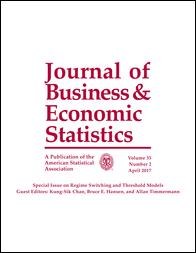
Harvey, AndrewC. and Koopman, S.J. (1992). Diagnostic checking of unobserved- components time series models Journal of Business and Economic Statistics, 10(4):377--389.
-
Affiliated author
-
Publication year1992
-
JournalJournal of Business and Economic Statistics
Diagnostic checking of the specification of time series models is normally carried out using the innovations—that is, the one-step-ahead prediction errors. In an unobserved-components model, other sets of residuals are available. These auxiliary residuals are estimators of the disturbances associated with the unobserved components. They can often yield information that is less apparent from the innovations, but they suffer from the disadvantage that they are serially correlated even in a correctly specified model with known parameters. This article shows how the properties of the auxiliary residuals may be obtained, how they are related to each other and to the innovations, and how they can be used to construct test statistics. Applications are presented showing how residuals can be used to detect and distinguish between outliers and structural change.